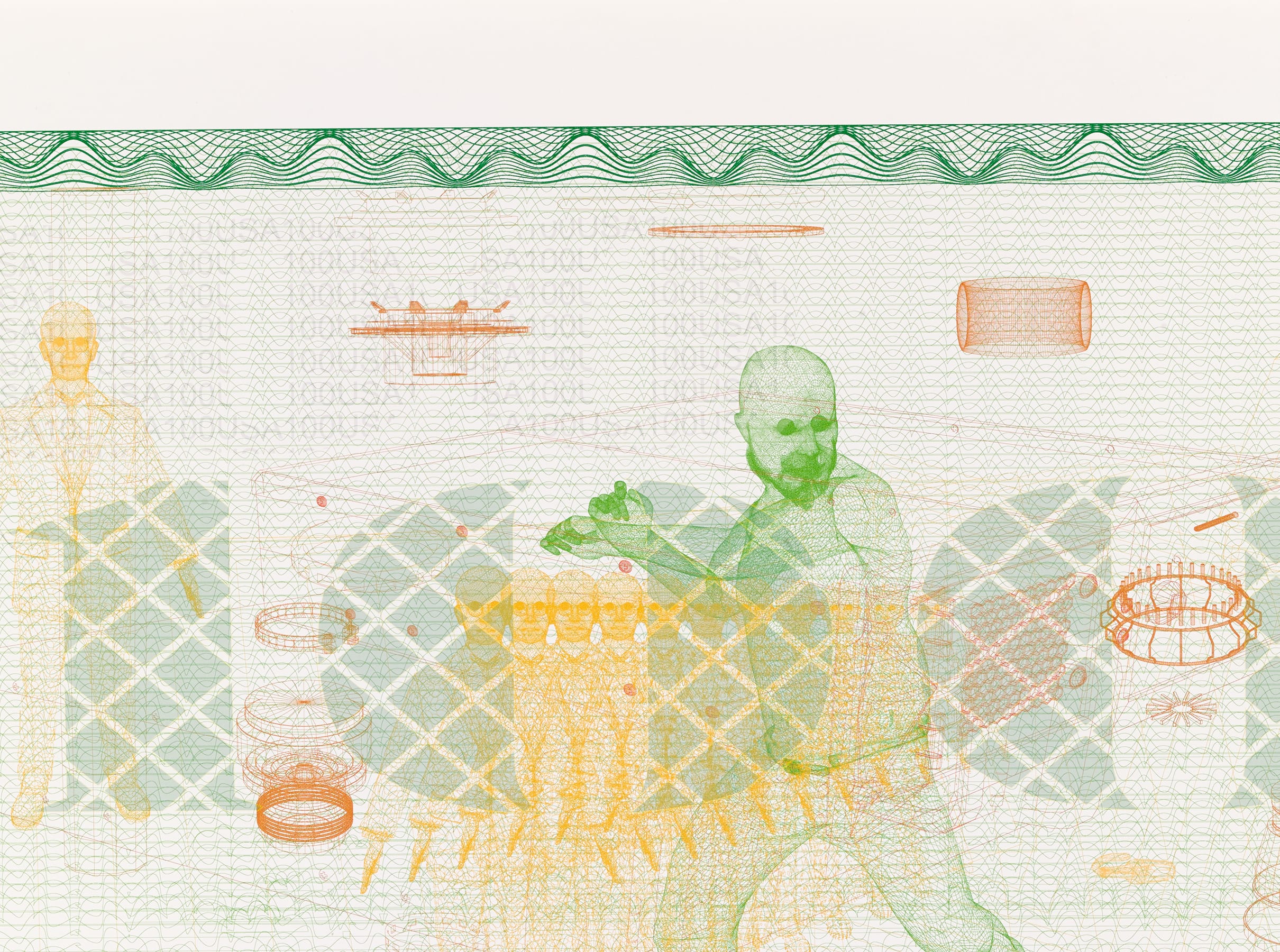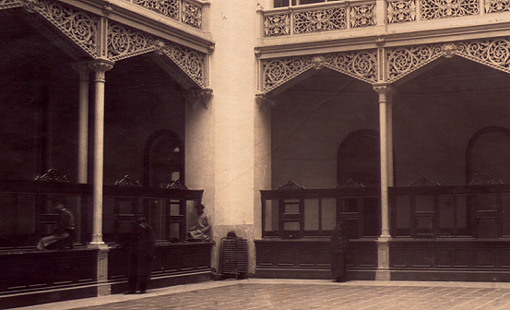
Photos of the Banco de España head office. A century of history
Work on the central headquarters of the Banco de España on Plaza Cibeles, with Eduardo de Adaro as the chief architect, was completed in 1891. This concluded an eight-year process that was not without its difficulties. The earliest known illustrated report on the building after its completion was carried out by the photographic agency J. Laurent y Cía., probably at the behest of the magazine La Ilustración Española y Americana![]() , which included several of the photos taken in the form of engravings in an issue published in the spring of 1891. The same report was also featured in the agency’s sales brochure. In their book Primeras fotografías del edificio del Banco de España (1891)
, which included several of the photos taken in the form of engravings in an issue published in the spring of 1891. The same report was also featured in the agency’s sales brochure. In their book Primeras fotografías del edificio del Banco de España (1891)![]() [‘Earliest Photos of the Banco de España Building (1891)’], Patricia Alonso and Elena Serrano write that this is proof of the extraordinary interest sparked by the new building in the society of the time.
[‘Earliest Photos of the Banco de España Building (1891)’], Patricia Alonso and Elena Serrano write that this is proof of the extraordinary interest sparked by the new building in the society of the time.
De Adaro's building continues to spark great interest today, as evidenced by the many pictures of it taken by photographers who have played a key role in introducing, developing and transforming documentary photography in Spain. An example of this is the exhibition The Architecture of Eduardo de Adaro and the Banco de España. A Changing World, which analyses the core role played by the Madrid-born architect in consolidating the iconographic image of the bank at a key point in its history.
 Javier Campano. The Goddess Fortuna on the façade of the Banco de España. From the series The Banco de España building, 2000-2001, Banco de España Collection | Candida Höfer. Banco de España, Madrid III 2000. Banco de España Collection | Jorge Ribalta. Restoration. 2017. Banco de España Collection
Javier Campano. The Goddess Fortuna on the façade of the Banco de España. From the series The Banco de España building, 2000-2001, Banco de España Collection | Candida Höfer. Banco de España, Madrid III 2000. Banco de España Collection | Jorge Ribalta. Restoration. 2017. Banco de España Collection
The exhibition features pictures by some of the photographers who best represent the birth of documentary photography in Spain, including Charles Clifford and J. Laurent y Cía., together with others by more contemporary photographers such as Candida Höfer, Manolo Laguillo, Jorge Ribalta and Javier Campano, all of whom have produced photographic projects on the building on Plaza Cibeles which now form part of the bank's art collection. The exhibition examines the life and legacy of Eduardo de Adaro and highlights the important role of documentary photography in chronicling the bank's head offices. It takes us on a journey through the history and evolution of this genre of photography in Spain, showcasing a number of highly significant items from the collection’s photography section.
The contemporary photos on show include several from the project Banco de España Madrid 2000, in which German photographer Candida Höfer, a stand-out member of the so-called "Düsseldorf School", probes what has been described as the "architecture of absence". The exhibition also features the series Adaro: A Case Study, by Manolo Laguillo, which looks not just at the building on Plaza Cibeles but also at other architectural projects by de Adaro, whose career led him to design buildings ranging from prisons to industrial, religious, residential and funerary buildings.
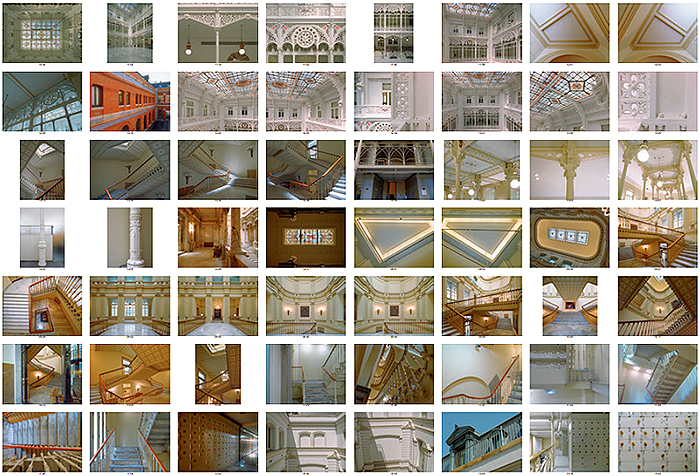
Manolo Laguillo. Adaro: A Case Study, 2021. Giclée (pigmented inks on archival-quality pH-neutral paper). Commissioned in 2021 Banco de España Collection
The series by Laguillo, a key figure in the renewal of architectural and urban photography in Spain, was made on commission from the bank. The Banco de España has been a patron of the arts through commissions from its earliest days. Examples include Restoration and The Banco de España Building, two other photo essays featured in the exhibition. In the former, Jorge Ribalta documents the restoration and cleaning work carried out on the building between 2017 and 2018, while at the same time presenting a polyhedral exercise in metalinguistic reflection on photography itself. The latter comprises over 150 photos taken by Javier Campano between 1981 and 2001, some of which have since become iconic images of the building.
The illustrated report by J. Laurent y Cía. is exceptionally useful because it shows the original appearance of the most representative parts of Adaro’s building, some of which were dismantled or significantly altered in a number of subsequent refurbishments. A case in point is the shareholders’ assembly hall: José Yarnoz’s refurbishment in the 1930s changed almost all the original decoration, depriving it of the lavish, lecture-hall look we see in the early photographs. That rich ornamentation can also be seen in another picture from the collection featured at the exhibition; it was painted in 1916 by Palencia-born artist Asterio Mañanós to mark King Alfonso XIII and Queen Victoria Eugenie’s visit to the bank.
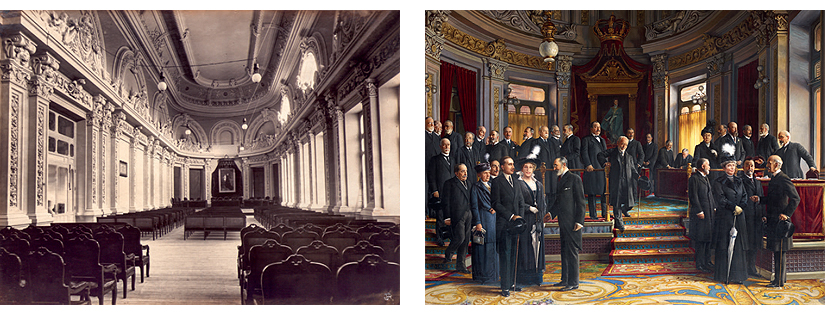 J. Laurent y Cía. Boardroom of the Banco de España in Madrid, 1891. Chemically developed with silver gel. Print by Juana Roig (1915-1921?). Historical Archives of the Banco de España, Photography Collection | Asterio Mañanós. Visit of King Alfonso XIII and Queen Victoria Eugenie to the Banco de España on 23 May 1915 (1916). Oil on canvas Commissioned in 1916 Banco de España Collection
J. Laurent y Cía. Boardroom of the Banco de España in Madrid, 1891. Chemically developed with silver gel. Print by Juana Roig (1915-1921?). Historical Archives of the Banco de España, Photography Collection | Asterio Mañanós. Visit of King Alfonso XIII and Queen Victoria Eugenie to the Banco de España on 23 May 1915 (1916). Oil on canvas Commissioned in 1916 Banco de España Collection
As mentioned, French photographer Jean Laurent was a key figure in the early days of documentary photography in Spain. He moved to Madrid in 1843 and set up a photography studio in the 1850s at No. 39, Carrera de San Jerónimo, very close to the future site of de Adaro's building. It became one of the most active and most prosperous studios in Spain in the second half of the 19th century. Carlos Martín argues that Laurent can be compared to Eduardo de Adaro in his rigorous approach to his work and constant interest in applying the latest technological advances in his field.
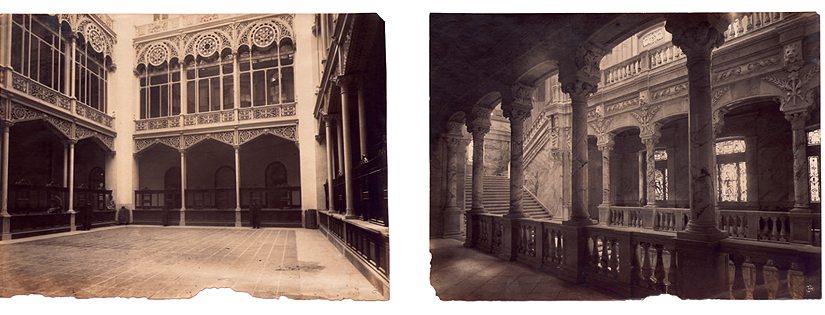 J. Laurent y Cía. Trading Floor, Banco de España, 1891 Print by Juana Roig (1915-1921?). Historical Archives of the Banco de España, Photography Collection | J. Laurent y Cía. Main staircase of the Banco de España in Madrid, 1891. Chemically developed with silver gel. Print by Juana Roig (1915-1921?). Historical Archives of the Banco de España, Photography Collection
J. Laurent y Cía. Trading Floor, Banco de España, 1891 Print by Juana Roig (1915-1921?). Historical Archives of the Banco de España, Photography Collection | J. Laurent y Cía. Main staircase of the Banco de España in Madrid, 1891. Chemically developed with silver gel. Print by Juana Roig (1915-1921?). Historical Archives of the Banco de España, Photography Collection
The illustrated report was produced in 1891, five years after Jean Laurent's death, so the pictures were of course not taken by him personally. In 1883 the studio was taken over by his stepdaughter Catalina Melina Dorsch. She and her husband Alfonso Roswag carried on the work that Laurent had begun three decades earlier. Nor does it seem likely that he took another, earlier photo, signed J. Laurent y Cía. which documents the early stages of the construction of the headquarters building at Plaza Cibeles in around 1886 or 1887. This photo shows a steam-driven crane at work. This crane was used to lift construction materials and heavy stone blocks to be placed on the façade.
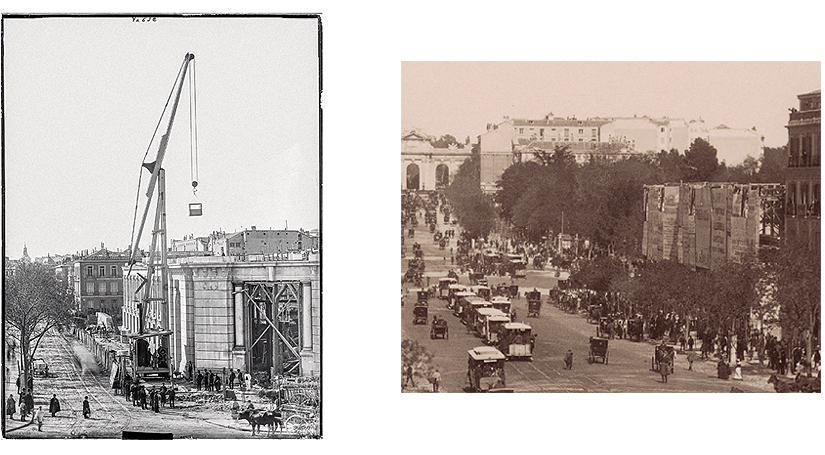 Laurent y Cía. Banco de España under construction, c. 1886. Ruiz Vernacci Archives, Spanish Cultural Heritage Institute, Ministry of Culture and Sport | View of the Puerta de Alcalá gate from Calle de Alcalá in Madrid. Photographer unknown, c. 1885-1886. Albumen Rijksmuseum Collection, Amsterdam
Laurent y Cía. Banco de España under construction, c. 1886. Ruiz Vernacci Archives, Spanish Cultural Heritage Institute, Ministry of Culture and Sport | View of the Puerta de Alcalá gate from Calle de Alcalá in Madrid. Photographer unknown, c. 1885-1886. Albumen Rijksmuseum Collection, Amsterdam
This photo from the Ruiz Vernacci Archives![]() at the Spanish Cultural Heritage Institute
at the Spanish Cultural Heritage Institute![]() , which answers to the Ministry of Culture and Sport, can also be seen at the exhibition. It is not, however, the oldest surviving photo of the building under construction. Painstaking research by Professor of Art History Esperanza Guillén for the book Eduardo Adaro. Arquitecto del Banco de España ['Eduardo de Adaro, Architect of the Banco de España'], published to coincide with the opening of the exhibition, has turned up an even older photo in the collection of the Rijksmuseum in Amsterdam
, which answers to the Ministry of Culture and Sport, can also be seen at the exhibition. It is not, however, the oldest surviving photo of the building under construction. Painstaking research by Professor of Art History Esperanza Guillén for the book Eduardo Adaro. Arquitecto del Banco de España ['Eduardo de Adaro, Architect of the Banco de España'], published to coincide with the opening of the exhibition, has turned up an even older photo in the collection of the Rijksmuseum in Amsterdam![]() that shows Calle de Alcalá with the wooden scaffolding for the future Banco de España building covered with advertising hoardings.
that shows Calle de Alcalá with the wooden scaffolding for the future Banco de España building covered with advertising hoardings.
